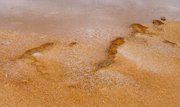Biofilm
|
|
A biofilm is a complex aggregation of microorganisms marked by the excretion of a protective and adhesive matrix. Biofilms are also often characterized by surface attachment, structural heterogeneity, genetic diversity, complex community interactions, and an extracellular matrix of polymeric substances.
Single-celled organisms generally exhibit two distinct modes of behavior. The first is the familiar free floating, or planktonic, form in which single cells float or swim independently in some liquid medium. The second is an attached state in which cells are closely packed and firmly attached to each other and usually a solid surface. The change in behaviour is triggered by a quorum sensing mechanism that varies among species. When a cell switches modes, it undergoes a phenotypic shift in behavior in which large suites of genes are up- and down- regulated.
| Contents |
Formation
Formation of a biofilm begins with the attachment of free-floating microorganisms to a surface. These first colonists adhere to the surface initially through weak, reversible van der Waals forces. If the colonists are not immediately separated from the surface, they can anchor themselves more permanently using cell adhesion molecules such as pili.
The first colonists facilitate the arrival of other cells by providing more diverse adhesion sites and beginning to build the matrix that holds the biofilm together. Some species are not able to attach to a surface on their own but are often able to anchor themselves to the matrix or directly to earlier colonists. Once colonization has begun, the biofilm grows through a combination of cell division and recruitment.
Properties
Biofilms are usually found on solid substrates submerged in or exposed to some aqueous solution, although they can form as floating mats on liquid surfaces. given sufficient resources for growth, a biofilm will quickly grow to be macroscopic. Biofilms usually consist of many species of bacteria and archaea, each perfroming speciallized metabolic functions. However, some organisms will form monospecies films under certain conditions. The biofilm is held together and protected by a matrix of excreted polymeric compounds. This matrix protects the cells within it and facilitates communication among them through chemical and physical signals. Some biofilms have been found to contain water channels that help distribute nutrients and signalling molecules. This matrix is strong enough that under certain conditions, biofilms can become fossilized.
Bacteria living in a biofilm usually have significantly different properties from free-floating bacteria of the same species, as the dense and protected environment of the film allows them to cooperate and interact in various ways. One benefit of this environment is increased resistance to detergents and antibiotics, as the dense extracellular matrix and the outer layer of cells protect the interior of the community. In some cases antibiotic resistance can be increased 1000 fold.
Examples
Biofilms are ubiquitous. Nearly every species of bacteria and archaea have mechanisms by which they can adhere to surfaces and to each other. Biofilms can be found on rocks and pebbles at the bottom of any stream or river and often form on the surace of stagnant pools of water. Biofilms grow in hot, acidic pools in Yellowstone and on glaciers in Antarctica.
Dental plaque is a biofilm. In industrial environments, biofilms can develop on the interiors of pipes and lead to clogs and corrosion. In medicine, a biofilm will form on any solid surface implated in the body. Biofilms spreading along implanted tubes or wires can lead to pernicious infections in patients. Insufficiently cleansed contact lenses will develop bioflims. Biofilms on floors and counters can make sanitation difficult in food preparation areas.
Biofilms can also be harnessed for constructive purposes. For example, many sewage treatment plants include a treatment stage in which waste water passes over biofilms grown on filters, which extract and digest harmful organic compounds.
References
- Allison, D. G.; Gilbert, P.; Lappin-Scott, H. M.; and Wilson, M. (eds) Community Structure and Co-operation in Biofilms Cambridge: Cambridge University Press. ISBN 0-521-79302-5de:Biofilm

